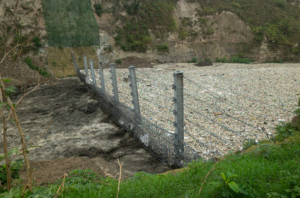
WATCH: Tsunami of plastic destined for Caribbean Sea

Ocean Cleanup has begun work on intercepting plastic pollution in what it thinks is the heaviest polluting river in the world by making a fence which stops rubbish getting into the sea.
For over three years the organisation has been working on developing a project in the Rio Motagua basin in Guatemala which, Ocean Cleanup says suffers yearly trash tsunamis, devastating the environment.
Geographic and municipal conditions mean an estimated 20,000 tonnes of plastic currently flows through the Rio Motagua into the Caribbean Sea on an annual basis. Based on this number, this one river alone is responsible for an estimated two per cent of global plastic emissions into the oceans, estimates Boyan Slat, Ocean Cleanup’s CEO.
Slat says the organisation is trialing a an Interceptor Trashfence which is still in its experimental stage.
“However we are learning all the time and our team is working hard to bring the system to full operability and begin intercepting plastic here as part of our ambition to address the 1000 heaviest polluting rivers in the world,” he says.
The Interceptor Trashfence borrows technology from avalanche and rockfall protection, where large steel fences are used to prevent heavy flows of material from passing through. This has been adapted to be applied to flows of rubbish coming down a river.
The concept is simple. A giant Trashfence is erected on a dry river bed. When the flash floods bring the rubbish washing down, the fence intercepts it and retains it in place. Once the water level comes down, excavators and trucks are used to remove the intercepted waste ready for the next flash flood, and the accompanying trash tsunami, when it arrives.
“The Trashfence stretches approximately 50 meters wide across the gorge, and stands eight meters tall,” says Blat. “The custom-engineered steel mesh is currently installed at a height of three meters. This height will be increased incrementally for greater efficiency as we gain more insight into the design.
“At this moment the Trashfence is still very much an experimental system, and is not yet operational. Huge quantities of plastic were initially halted, but the structure did not hold and suffered damage due to the massive pressure of the flood. The first flash floods showed us what works and what doesn’t work, which we can learn from and use for subsequent adjustments. We expect to spend some time optimising the exact setup (foundation, mesh sizes, fence height), while investigating whether one deployment is enough to stop these trash tsunamis or whether another Trashfence is needed.”
The Rio Motagua is the largest river in Guatemala, stretching from the highlands in the west down to the Caribbean Sea in the east. An urban landfill sits on the top of one of its tributaries, the Rio Las Vacas. Like many other rivers in the region, the Rio Motagua also suffers from unlicensed waste dumping.
During the rainy season, these factors lead to exceptionally heavy flows of rubbish flowing into the Rio Motagua every year, adding to the plastic pollution problem in the Caribbean Sea.
“We estimate that up to 20,000 tonnes of plastic is flowing through the Rio Motagua basin on an annual basis,” says Slat. “This would equate to roughly 2% of the world’s overall plastic emissions to the oceans. To draw an analogy: all airplane emissions, worldwide, total 1.9% of global CO2 emissions. Our estimates suggest that stopping the flow of plastic in this one river could have a proportionally similar reductive impact on plastic emissions as the elimination of all air travel would have on carbon emissions.
“Pollution from the Rio Motagua has even been observed from space using satellites. This evidence contributes to our growing belief that the Rio Motagua is the number one heaviest-emitting river in the world.
“An obvious question is why we chose to deploy an Interceptor in the river, rather than trying to prevent trash from washing into the river in the first place. At The Ocean Cleanup we are pragmatists, and given the urgency of the problem we choose to focus on what we can practically do right now to reduce the amount of plastic reaching the ocean. We also recognise the long-standing efforts of city authorities to address these difficult civic waste management challenges and the socio-economic circumstances fuelling unofficial waste disposal.
“Thankfully, authorities are working hard to improve waste management and in particular address issues with the landfill, but naturally this will take time. The Ocean Cleanup remains in close collaboration with city authorities and will contribute to any discussions on how to address this endemic but solvable problem. However until that solution is found, The Ocean Cleanup aims to help by intercepting any plastic that leaks out, to ensure it never reaches the ocean.”
In January this year, MIN reported that marine plastics will outweigh the total mass of fish in the world’s oceans by 2050, according to the Environment Investigation Agency. This follows Ocean Cleanup deploying its first large-scale, 800m system to clean up the Great Pacific Garbage Patch in Sept 2021.
